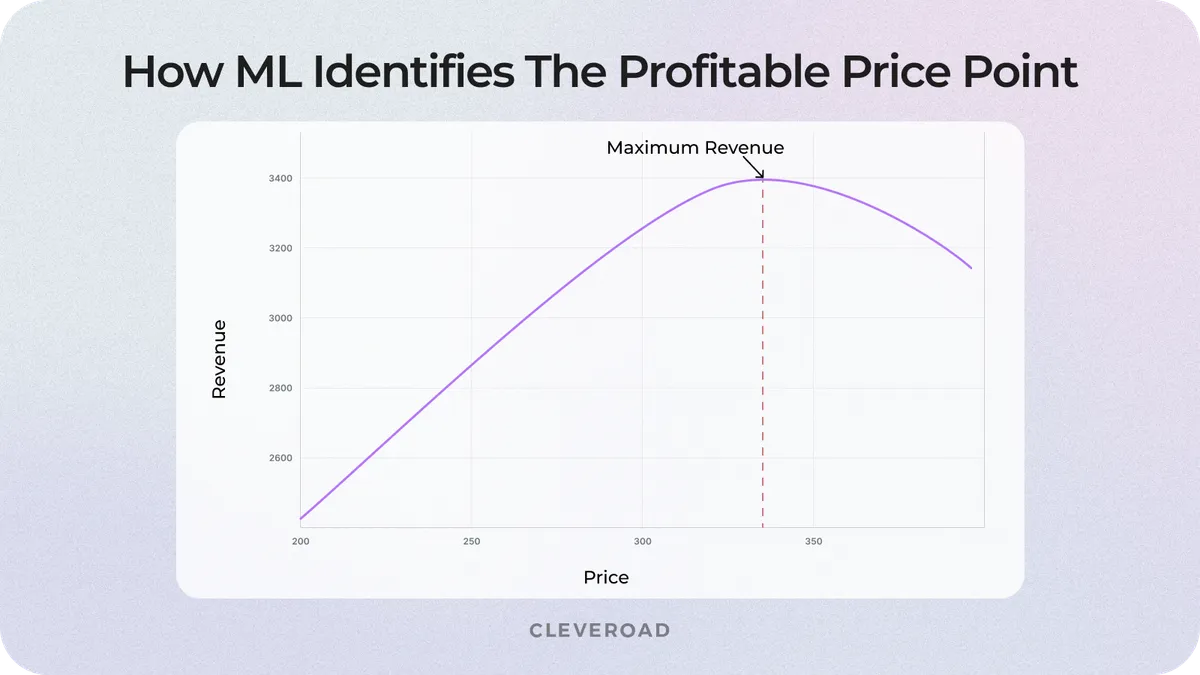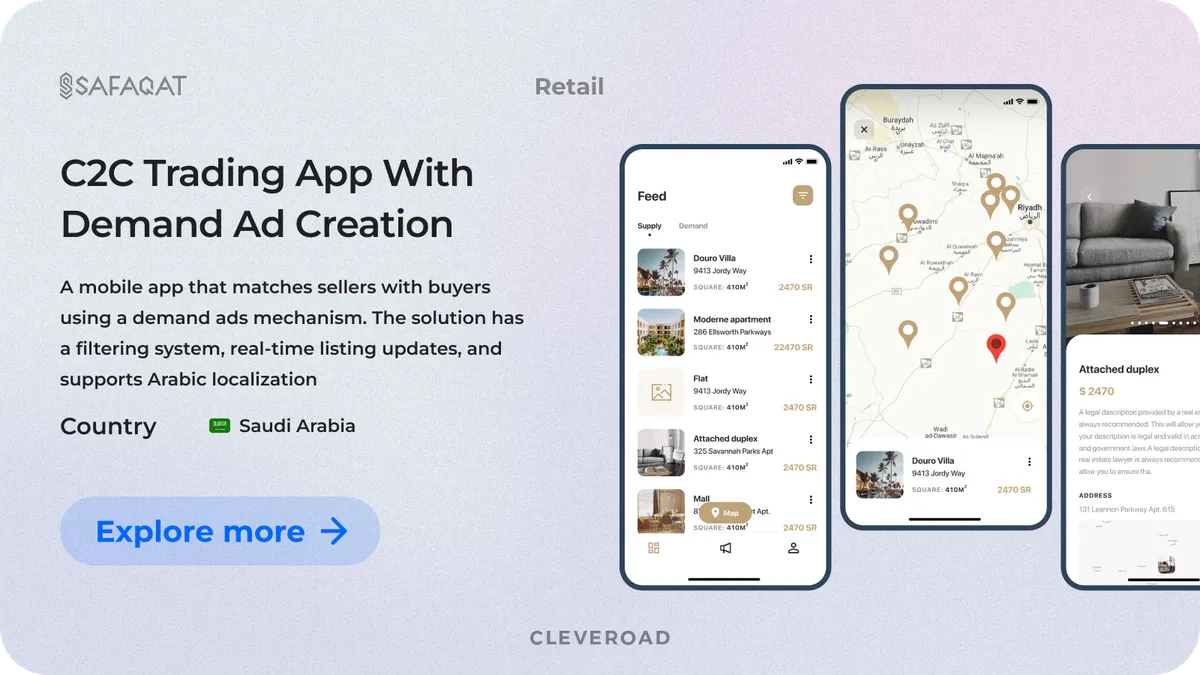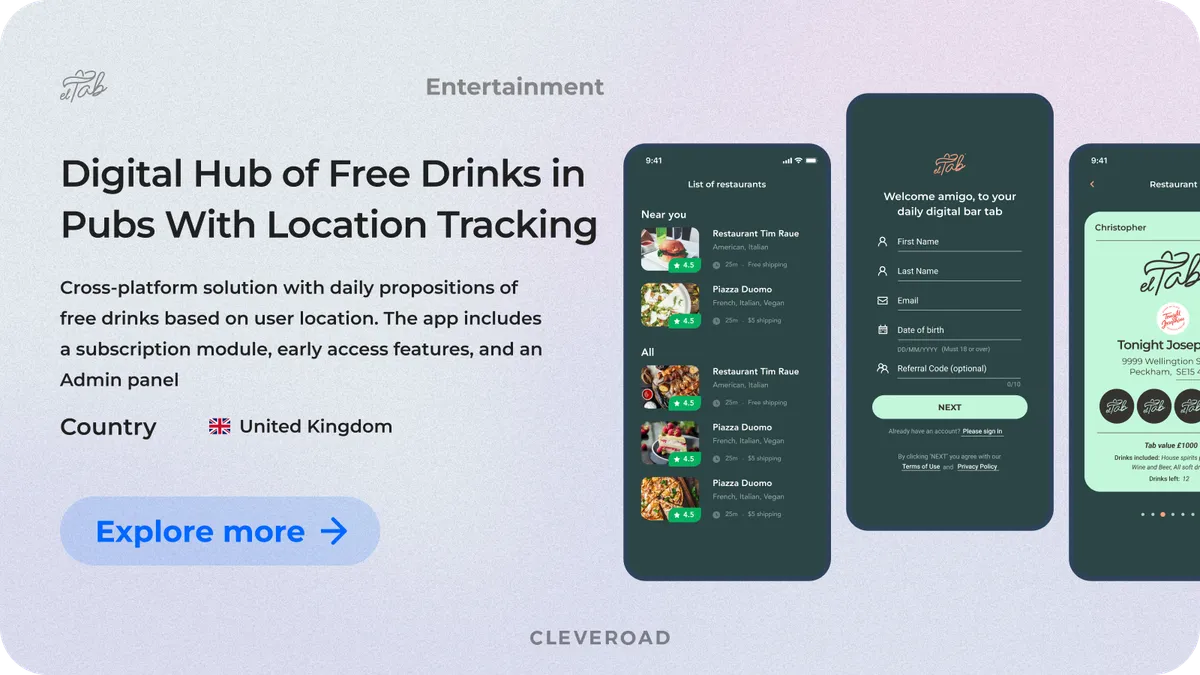Price Optimization Machine Learning: How to Accelerate Margins in Your Business Strategy
19 Nov 2025
15 Min
113 Views
Wouldn’t it be great if your prices could set themselves? Machine learning price optimization is the tool that makes it possible. ML lets your data determine the right price at the right time, helping your business stay profitable without constant guesswork.
In this article, you explore what price optimization machine learning is, how it works, how you will benefit from implementing it, and how to deal with common implementation challenges.
Key takeaways:
- ML helps identify the optimal price points by analyzing demand patterns, competitor pricing, and customer behavior, removing guesswork from your strategy
- Machine learning optimized pricing can adjust in real time to reflect actual market trends and seasonal shifts, keeping your margins healthy
- Machine learning enables personalized pricing for different customer segments, increasing conversions while maintaining profitability
What Is Machine Learning for Price Optimization?
Machine learning for price optimization is a way to find the most profitable price for a product or service by analyzing real market behavior instead of relying on guesswork. It continuously learns from factors like demand shifts, customer behavior, competitor pricing, seasonality, and past sales performance to predict how buyers will respond to different price points. ML recommends (or automatically applies) prices that maximize revenue or margin while keeping sales steady, becoming more accurate over time as it processes more data.
How price optimization using machine learning works
ML-powered price optimization follows a structured workflow that helps businesses turn raw data into accurate, revenue-boosting price recommendations. Here’s how the process typically works:
- Data collection. Gather historical sales, pricing, customer behavior, competitor data, and trends.
- Data preprocessing. Clean, normalize, and structure the data to remove errors.
- Model training. Use ML to learn relationships between price changes and customer responses.
- Continuous learning. Continuously update the model with new data so pricing stays accurate.
Rule-based pricing vs. ML-driven optimization
When setting prices, businesses can rely on traditional rules or leverage machine learning for dynamic decisions. Here’s how the two approaches compare:
- Rule-based pricing. Uses fixed formulas or manual rules (e.g., cost-plus, competitor matching). Simple to implement but inflexible and unable to respond to changing market conditions.
- ML-driven optimization. Analyzes historical and real-time data to predict demand at price points. Continuously learns and adapts, recommending prices that maximize revenue or profit.
Here’s the key difference: Rule-based pricing is static and predictable, providing straightforward but limited insights. ML-driven optimization, in contrast, is dynamic, data-driven, and context-aware. It can detect subtle patterns in customer behavior, seasonality, and market trends, enabling businesses to adjust prices in real time.
Below, you can examine the more detailed definition:
| Aspect | Rule-based pricing | ML-driven optimization |
Approach | Fixed rules | AI predicts optimal prices |
Flexibility | Static | Dynamic, adapts automatically |
Data | Limited | Historical and real-time |
Accuracy | Basic | High, revenue-focused |
Scalability | Manual | Easily scales |
Decision | Human-driven | AI-driven, self-improving |
Machine Learning Price Optimization Models and Algorithms
ML price optimization models help companies set the right price at the right moment. They analyze market trends, customer behavior, and product data to predict how pricing changes will affect sales and revenue. Below are the most common ML models used to build effective pricing strategies.
Regression models
Regression models predict how price changes impact demand and revenue by analyzing historical sales and pricing data. They are simple and effective for straightforward pricing strategies, allowing businesses to understand direct relationships between price and customer behavior.
Tree-based models
Tree-based price optimization machine learning models, including decision trees and ensemble methods like random forests or gradient boosting, capture complex, non-linear interactions between multiple factors affecting price. They are highly effective for multi-product or multi-channel environments, providing robust predictions even with large, varied datasets.
Neural networks for complex pattern recognition
Neural networks process large, intricate datasets to uncover hidden patterns, trends, and correlations that simpler models may overlook. These models are ideal for products with many influencing factors or dynamic customer behavior, enabling highly accurate price recommendations.
Reinforcement learning for dynamic environments
Reinforcement learning continuously tests and adapts pricing strategies based on real-time market feedback. By learning from customer responses and competitive changes, it identifies optimal pricing policies over time, maximizing long-term revenue in dynamic, fast-changing markets.
Price elasticity modeling
Price elasticity modeling measures how sensitive customers are to changes in price, helping businesses determine the optimal balance between sales volume and profitability. This approach supports informed decision-making, enabling smarter pricing adjustments that reflect real customer behavior and market conditions.
Learn more about AI development services we provide at Cleveroad and how we can help you create a high quality ML-based price optimization solution
Benefits of Machine Learning for Price Optimization
Intelligent machine learning algorithms help you gain significantly more clarity on your pricing blind spots and how to better cater to your clients. We’ve researched the market and found some real success cases to outline the key benefits of price optimization machine learning you may receive.
Higher revenue and profitability
According to Revionics, ML-driven pricing can increase gross profit by 5-10% by finding price points that maximize revenue without hurting demand. Machine learning uncovers patterns humans would miss, such as hidden margin pockets, underpriced Stock Keeping Units (SKUs), or products consumers are willing to pay more for — giving your business a direct and measurable boost in profitability.

How machine learning fro price optimization works
Real-time dynamic pricing
Machine learning adjusts prices automatically based on changing factors like demand, inventory, and competitor activity. Companies using real-time dynamic pricing see higher margins because they react to market shifts instantly, not days later. This prevents revenue loss during demand spikes and protects your bottom line when competition intensifies.
Customer segmentation and personalized pricing
Machine learning price optimization models create fine-grained customer segments and match price points to each group’s willingness to pay. This drives higher conversions, increases basket value, and improves customer satisfaction. Businesses can target high-value segments more effectively, reduce churn, and strengthen long-term customer loyalty.
Competitive advantage with adaptive strategies
SuperAGI reports that organizations applying adaptive ML pricing strategies gain a clear competitive edge by continuously updating prices based on live market insights. Around 75% of companies using AI-driven price optimization see notable revenue growth, with some exceeding a 10% lift. The advantage compounds: the longer ML runs, the smarter and more profitable your pricing becomes.
Scalability across products, regions, and channels
Machine learning scales seamlessly across thousands of SKUs, multiple locations, and diverse sales channels, something manual pricing teams cannot physically handle. As your business grows, ML ensures pricing stays consistent, efficient, and optimized everywhere. This removes operational bottlenecks and supports fast expansion into new markets without increasing overhead.
Key Use Cases of Price Optimization Machine Learning Across Industries
Businessess in various industries use price optimization ML to satisfy their specific needs and resolve domain-specific issues. Below are the core industries where price optimization machine learning delivers the strongest impact, along with real-world examples showing how leading companies use these models in practice.
Travel and Hospitality
In travel, ML-powered price optimization dynamically optimizes flight, hotel, and vacation package prices by analyzing booking windows, demand surges, competitor rates, and historical patterns.
Real-world example: Airbnb applies efficient machine learning algorithms to recommend “Smart Pricing” to hosts, automatically adjusting nightly rates based on demand, local events, seasonal trends, and occupancy levels.
Retail and eCommerce
Machine learning helps retailers adjust prices in real time based on demand, inventory levels, seasonality, and shopper behavior. It also enables personalized pricing, discount optimization, and smarter promotional strategies.
Real-world example: Amazon uses large-scale machine learning price optimization models to update prices on millions of products multiple times per day, optimizing margins while staying competitive in dynamic markets.
Get insights on AI in Retail and eCommerce to learn how it works and how it’s possible to implement it within your operations
Logistics
Providers apply machine learning in logistics for price optimization to account for fluctuating fuel costs, shipment urgency, lane demand, freight class, and capacity constraints, ensuring quotes stay competitive and profitable.
Real-world example: UPS leverages machine learning to dynamically optimize shipping rates, factoring in distance, package type, traffic patterns, and operational efficiency to improve margins and transportation services quality and trustworthiness.
Software-as-a-Service (SaaS)
SaaS companies use ML to determine subscription pricing, optimize trial-to-paid conversions, and identify the most profitable pricing tiers by evaluating usage patterns, churn risks, customer lifetime value, and feature demand.
Real-world example: HubSpot uses predictive analytics and machine learning to evaluate customer usage data and adjust pricing and packaging strategies to maximize LTV and upsell opportunities.
Use our AI business advisor to define which price optimization ML model will better integrate within your business structure
Steps to Implement Price Optimization Using Machine Learning
We compiled a roadmap to create price optimization ML model, based on insights from our in-house ML engineers, solution architects, and data scientists who design pricing engines for retail, SaaS, logistics, and marketplace clients. It reflects the practical steps we follow when building and deploying machine learning price optimization models in real commercial environments.
1. Define business goals
You’ll need to begin by turning broad commercial objectives into clear, measurable targets that a machine learning system can optimize against. This means breaking down high-level ambitions, like improving margins, or stabilizing inventory, into quantifiable goals and explicit constraints.
For example, instead of “increase profitability,” define goals such as boosting margin by 4% in Category A, increasing conversion rates for price-sensitive segments by 6%, or reducing stockouts during peak periods by 20%.
2. Gather and preprocess sales data
High-quality inputs are essential for any machine learning pricing system to work reliably. You’ll need to ensure that all relevant data sources are complete, accurate, and consistently structured before modeling begins.
Data gathering process includes aspects like:
- Transactional history,
- Product catalog details
- Inventory levels
- Customer behavior patterns
- Competitor price feeds
- Promotional records
- External variables ( e.g., seasonality, weather, etc.)
3. Choose the right ML model
Pick the type of model that aligns with how complex your pricing is and how much data you can feed it. This could be anything from basic regression to tree models, neural networks, or reinforcement learning for highly dynamic pricing.
How we at Cleveroad assist you during this stage:
- Model evaluation lab. Run lightweight experiments (scikit-learn, XGBoost, LightGBM, TensorFlow/PyTorch, RL libraries like Stable Baselines3) to benchmark approaches.
- Explainability and risk checks. Apply SHAP/LIME for feature importance, run fairness checks, and quantify uncertainty (prediction intervals) to ensure decisions are auditable.
- Hybrid approach. We combine rule-based priors and Bayesian/transfer learning with ML models; for fast-moving categories, consider bandit or reinforcement-learning agents.
- Model selection report. Provide trade-offs (latency, accuracy, interpretability) and recommend a primary model and a fallback.
Build a Proof of Concept (PoC)
At this stage, our team validates that the pricing model actually works with your real data and business logic. We prepare a clean dataset, run feature engineering, and test several machine learning techniques (regressions, tree-based models, neural nets, RL for dynamic scenarios) to identify the best performer. The PoC is deployed in a controlled environment as a lightweight, Dockerized service so your team can test pricing outputs through simple REST or gRPC endpoints.
You receive a functioning prototype, model evaluation reports, and clear success criteria, allowing you to confirm ROI before moving into a full-scale rollout.
We provide AI Proof-of-Concept services you can use to define if the price optimization machine learning will work as expected before the development
Expand capabilities & integrate into your business systems
Once the model proves its value, we scale it into production. This includes building an API-first, microservices-based pricing engine, configuring both batch and real-time inference flows, and deploying it to Kubernetes (EKS/GKE/AKS) for reliable performance. We connect the solution to your internal ecosystem, ERP, CRM, POS systems, eCommerce platforms, or BI tools, using integration adapters and secure data pipelines.
To ensure smooth long-term operation, we set up CI/CD and MLOps workflows (GitHub Actions, GitLab CI, Jenkins) for automated training, testing, and releases, along with model governance tools like MLflow or Weights & Biases for versioning and monitoring. The results include the production-ready service and runbooks that help your team manage and evolve the system.
Monitor and refine continuously
Finally, we set up model monitoring and alerts for data drift, prediction shifts, and performance changes using Prometheus, Grafana, and specialized tools. We also automate retraining pipelines with Airflow and MLflow, using blue/green or canary deployments for updates.
We wrap it up with audit logs, explainability, and governance, including dashboards for review, manual overrides, and human-in-loop checks for high-risk pricing. Continuous improvement is supported through post-mortems, feature updates, and A/B testing.
Challenges in Machine Learning for Price Optimization
Using machine learning for price optimization also raises several important challenges. Below are the key issues you may face, and also how we at Cleveroad, as a development partner with 15+ years of experience in software development, can help you mitigate them.
Data quality and availability
ML models heavily depend on high-quality, granular data (such as sales history, customer behavior, competitor prices). Incomplete, inconsistent, or biased data can lead to inaccurate predictions and suboptimal pricing.
Cleveroad’s solution: We conduct a thorough data audit and preprocessing phase, cleaning, normalizing, and enriching your data before model training. If your historical data is sparse, we help integrate external data sources (e.g., market feeds, third-party pricing platforms) and design data-collection pipelines to improve future data quality.
Cold-start problem with new products
For newly launched products or SKUs, there may be very little historical data, making it hard for ML models to predict demand or set optimal prices.
Cleveroad’s solution: Our experts address the cold-start problem using hybrid strategies: we leverage proxy data (similar product performance, market benchmarks), implement Bayesian or transfer learning techniques, and build initial predictive models that are gradually refined as real transaction data comes in.
Risk of customer backlash with dynamic pricing
Customers may perceive machine learning price optimization techniques or dynamic pricing as unfair or exploitative, especially if they see frequent price fluctuations or personalized discounts. This can lead to negative sentiment, churn, or brand damage.
Cleveroad’s solution: We design transparent dynamic-pricing systems with guardrails to set price change limits (caps on discounts/increases), use AI agents to simulate customer reactions, and implement customer-facing communications (e.g., “smart pricing based on demand” disclosure) to build trust.
Regulatory and ethical considerations
Price optimization models can raise legal or ethical concerns if not carefully managed. For example, they might lead to price discrimination, charging different customers unfairly based on personal data or purchasing patterns. A lack of transparency in how prices are determined can erode customer trust and brand reputation. Additionally, models may violate regional regulations if pricing rules don’t comply with local laws or industry standards.
Cleveroad’s solution: Cleveroad includes compliance and ethics reviews as part of the development cycle, ensuring models are designed in line with local pricing laws, anti-discrimination policies, and data privacy regulations. We also implement logging and audit trails in the pricing system so pricing decisions can be reviewed and justified.
Technical integration challenges
Integrating ML-based pricing into existing business systems, such as ERP, CRM, or e-commerce platforms, can be challenging because these systems were often not designed to handle dynamic, real-time price updates. Legacy systems may lack the necessary APIs or flexibility to accept automated price changes. Data silos can prevent the model from accessing all relevant sales, inventory, or customer information, reducing prediction accuracy. Additionally, real-time pricing demands require low-latency infrastructure and robust monitoring, which can be difficult to implement without careful system architecture and workflow adjustments.
Cleveroad’s solution: We adopt a modular, API-first architecture that allows seamless integration of pricing engines with your existing infrastructure. Cleveroad’s engineers design microservices or multi-agent systems that interact with your ERP/CRM, build robust CI/CD pipelines, and perform load testing to ensure real-time pricing decisions scale reliably without disruption.
Note: If you plan to enhance your pricing strategy with ML model, feel free to contact us. As an experienced tech partner, we can help you predict potential ML price optimization challenges and successfully mitigate them
Why Partner With Cleveroad for ML-Powered Price Optimization
Cleveroad is a skilled software development vendor with deep expertise in machine learning and a strong background in retail, eCommerce, and SaaS solutions. Our team delivers end-to-end AI-assisted software development services, including AI consulting, PoC creation, custom Ai-based software development, ML development and more.
For more than 15 years, we help startups, mid-sized companies, and large enterprises implement ML-powered pricing strategies that maximize revenue, improve margins, and streamline operations through data-driven automation.
When you partner with Cleveroad for ML price optimization, you benefit from:
- AI strategy workshops: We identify the most impactful use cases for price optimization machine learning, define KPIs, and create a roadmap from concept to full integration
- Accelerated development with proven ML frameworks: We leverage pre-built ML models like AWS (SageMaker) and GCP (Vertex AI) to speed up the development
- Flexible integration across your software ecosystem: Our team can embed ML models into any system, like ERP, CRM, e-commerce platforms, and custom apps
- AI Proof-of-Concept development: Validate ML-based pricing solutions within your existing IT ecosystem before scaling, ensuring measurable results and reducing risk.
- ISO-Certified Processes: ISO 9001:2015 and ISO/IEC 27001:2013 compliance guarantees quality, security, and trust across every stage of cooperation
To prove our expertise in software development, we'd like to tell you about our recent cases – a location-based marketplace and a trading marketplace in Saudi Arabia.
Safaqat – a trading marketplace
For our client from Saudi Arabia, we've created a multi-purpose trading app called Safaqat. Safaqat is a multi-purpose trading marketplace in Saudi Arabia that connects buyers and sellers through supply-and-demand ads. Beyond matching real estate offers, the platform uses machine learning to optimize pricing based on demand patterns, helping sellers price their listings competitively while boosting conversion rates.
The trading marketplace includes native iOS and Android apps with Arabic and English UIs, supporting right-to-left, and a sophisticated search and matching system with advanced filters. We've also developed an admin panel that ensures seamless user and ad management.
Here’s what Mohareb Alshadi, owner of Safaqat, says about our collaboration:


El Tab – location-based marketplace
For our client in the UK, we developed El Tab, a location-based marketplace for bars and pubs in London. The Flutter app allows users to purchase drink subscriptions and receive notifications about participating venues. The platform integrates machine learning for price optimization, dynamically adjusting subscription offers to maximize customer engagement and venue revenue.
The marketplace includes a user-friendly interface and supports seamless payments via Apple Pay and Google Pay. Our team also built a robust admin panel to manage users and partner pubs, ensuring smooth operations, easy content management, and an engaging marketplace experience for both customers and venue partners.
Here’s what Oliver Carew, Founder of El Tab, says about collaboration with us:
Oliver Carew, Founder of El Tab, provides feedback about collaboration with Cleveroad
Machine learning price optimization uses AI algorithms to analyze historical sales, customer behavior, competitor prices, and external factors to automatically recommend or adjust product prices. The goal is to maximize revenue, margins, or market share while responding dynamically to changing demand and market conditions.
- Increased revenue and profitability: AI identifies the optimal price points for each product or segment
- Real-time, dynamic pricing: Adjust prices automatically based on demand fluctuations, competitor activity, and other market signals
- Personalized pricing and customer segmentation: Tailor prices to specific customer groups or purchase behavior
- Scalability and efficiency: Apply optimized pricing across multiple products, regions, and channels without manual intervention
Retail, eCommerce, travel, hospitality, SaaS, logistics, and energy sectors gain the most from data science applications. Any business with high transaction volume, variable demand, or a complex product catalog can benefit from machine learning techniques for pricing, which can help maximize profits by automatically adjusting prices based on customer behavior, market trends, and historical sales data.
The main challenges of implementing price optimization ML include:
- Ensuring high-quality and clean data from sales, inventory, and external sources
- Handling new products or cold-start scenarios with little historical data.
- Mitigating customer backlash from frequent price changes or dynamic pricing.
- Navigating regulatory and ethical constraints in pricing practices.
- Integrating ML solutions into existing IT systems, ERP, and e-commerce platforms

Evgeniy Altynpara is a CTO and member of the Forbes Councils’ community of tech professionals. He is an expert in software development and technological entrepreneurship and has 10+years of experience in digital transformation consulting in Healthcare, FinTech, Supply Chain and Logistics
Give us your impressions about this article
Give us your impressions about this article

